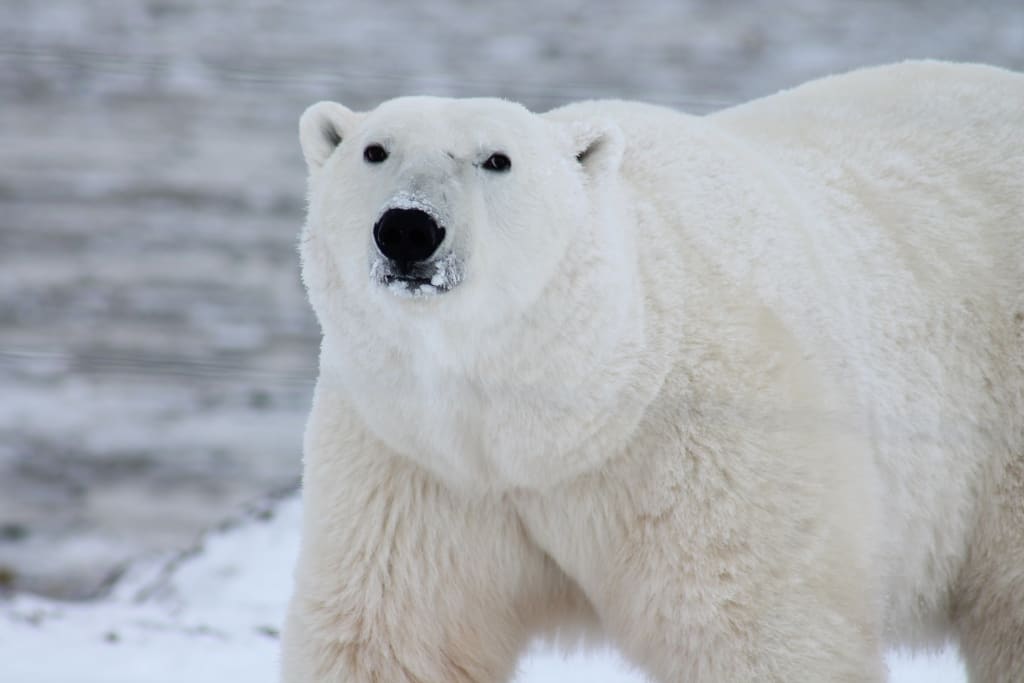Highlights of Arctic Exploration Polar Bears
Polar Bears

the Arctic, but my polar bear encounters, even the brief ones, remain imprinted on my memory with surprising clarity. None more so than the encounter we had in Croker Bay, on the southern shores of Canada's Devon Island. It was early morning, well before breakfast. A heavy fog sat to the north, and our ship slowly cruised through the mirror pond waters in search for wildlife. Binoculars scanned the hillsides for any irregularities, any cream-colored dots amongst the browns and maroons of the Devon Island terrain.
Jaymie, a long-time guide, spotted a bear several miles away, halfway up the hillside, slowly sauntering off into the distance. Step by step, but unfortunately, in the direction of the fog. Our ship inched closer, hoping to get a decent view before the bear disappeared into the cloud soup that enshrouded the north half of Croker Bay. Guests already began to gather on the ship's bow, getting long-distance looks at the king of the north.
As we progressed deeper into the bay, we altered course slightly to avoid a collection of small icebergs working their way south. There was no wind, but the tidal current gently spun these radiantly blue bergs to reveal their hidden sides. Revealing much more, it turned out.
Jaymie broke the silence: “Polar bear!” I laughed, thinking she was again pointing out the bear in the distance, disappearing into the fog. But then she pointed to a berg dead ahead of us, and said again, “there's a bear on the iceberg, right in front of us!” It had just come into view, previously hidden in the micro-topography of this miniature floating world.
Scarlet red stains drenched a depression on the iceberg, and a small purple-gray mass sat motionless at the bear's feet. The electric blues of the iceberg's base contrasted sharply with the whites of its top, and the bright reds of the circle of life. Standing broadside to us was a big bear, very well fed for late summer with a heavy belly full of food. We approached at a respectable distance, near idle speed, in total silence. The bear never looked up, focused on its all-important prize of the day: a fresh ringed seal.The ship stopped, drifting with the current just as the icebergs did. And the bear continued to eat, drifting across the bay and toward the port side of the ship. It seemed like everyone aboard the ship was on its bow, camera in hand, watching in near silence. A few excited exclamations here and there, but otherwise we were completely focused on the spectacle of the apex predator of the Arctic slowly drifting by, finishing up its hard-won breakfast. And in that moment, the bear stopped being just a symbol. It stopped being a thing, a bucket list item.
In that moment, the bear was a living, breathing animal caught up in a highly demanding food web, in a wilderness where the rules are quite literally “eat or be eaten.” Silence descended over the bay, and we heard the bear sneeze after a few bites of seal. We could distinctly make out its dark eyes set against its pale white coat. We began to understand the remarkable essence of this creature, foraging for food in this vast landscape in all seasons – the relative warmth and sunshine of the summer and the total darkness of the freezing cold winter.
Such serene conditions, the lingering fog, the mirror pond water, the lack of any breeze whatsoever, created a strangely perfect dichotomy with the circle of life on full display. And this scene will remain forever vivid in my mind. Decades from now, I will remember this icon persevering atop his iceberg, a meal of ringed seal in the challenging season of late summer. I know that this same scene will remain in the memories of dozens of guests from around the world, living in the minds of people from Australia to England, from Canada to China.
No wildlife encounter is ever scripted on expedition to the arctic. When entering the wilderness, you never know exactly what's going to happen, what animals will be passing through, which will be hunting, which will be resting, which will be out and about in some other location, not to be seen today. And that's the beauty of the wilderness.There are many iconic species in the Arctic, large, nearly-mythical animals that are found nowhere else on earth. Walrus, beluga whales, narwhals, snowy owls, musk ox, and more. All of these species have minds of their own, and cover great distances on their constant quest for food and social needs. But all of them have the same power as the polar bear, the power to stop us in our tracks and leave us in a deep state of appreciation, an all-encompassing sense of wonder, that help us feel the intensity and the life of the Arctic.
Thank you
About the Creator
THAO A NU
Hello my name is Nu I am a student
Enjoyed the story? Support the Creator.
Subscribe for free to receive all their stories in your feed. You could also pledge your support or give them a one-off tip, letting them know you appreciate their work.






Comments (1)
Well written!